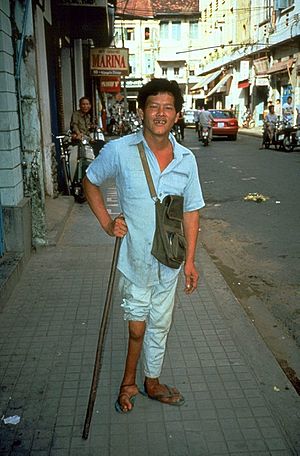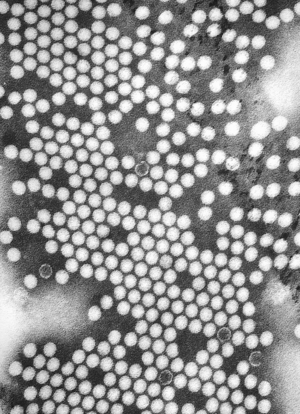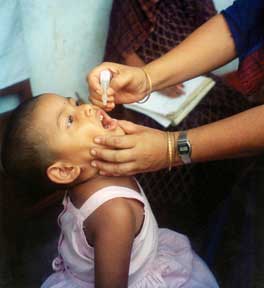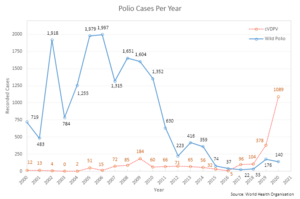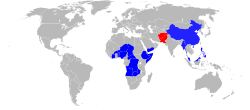Poliomyelitis facts for kids
Poliomyelitis, usually called polio, is a serious disease caused by a virus. This virus spreads easily from one person to another.
Most of the time, people who get polio don't feel sick at all. But if the virus gets into the brain or spinal cord (your central nervous system), it can make muscles weak or even paralyzed. Some people get better from this paralysis. Others might have lasting disabilities. Depending on which muscles are affected, they might need a wheelchair, have trouble using their hands, or even find it hard to breathe.
Polio is very dangerous for adults. About 15 out of every 10,000 adults who get polio can die from it.
The good news is that vaccines can stop polio. Groups like the World Health Organization have worked hard to give polio vaccines to people everywhere. Because of these efforts, polio has been wiped out in most countries around the world.
Polio has become much less common over the last few decades. In 1988, there were about 350,000 polio cases worldwide. By 2007, this number dropped by more than 99.9% to just 1,652 cases.
Did you know that Franklin D. Roosevelt, the 32nd President of the United States, had polio? He is the only U.S. President to have had this disease.
Contents
Polio Through History

People have known about the effects of polio for a very long time. Ancient Egyptian paintings and carvings show healthy-looking people with thin legs, and young children using canes. This suggests polio was around thousands of years ago. The first clear description of polio was written by an English doctor, Michael Underwood, in 1789. He called it "a weakness of the lower legs."
Before the 1900s, babies rarely got polio. Most cases were in children aged six months to four years. Back then, poor sanitation (like how waste was handled) meant people were often exposed to the virus. This helped them build up a natural immunity.
In richer countries during the late 1800s and early 1900s, sanitation got much better. There was improved sewage disposal and cleaner water. While this was good for health overall, it meant fewer children were exposed to the polio virus when they were very young. So, they didn't build up immunity, and more children and adults were at risk of getting paralytic polio.
Small local polio outbreaks started appearing in Europe and the United States around 1900. By the mid-1900s, these outbreaks became huge, spreading across Europe, North America, Australia, and New Zealand. In the United States, the worst outbreak was in 1952. Nearly 58,000 cases were reported that year. Sadly, 3,145 people died, and over 21,000 were left with some form of paralysis.
The fight against polio even led to the creation of intensive care units (ICUs). In the 1950s, many hospitals didn't have enough iron lungs, which were machines that helped patients breathe. In 1952, a Danish doctor named Bjørn Ibsen set up special centers in Copenhagen to help polio patients who couldn't breathe on their own. These centers were the first modern ICUs.
Polio epidemics changed many lives. They also led to big cultural shifts. People started huge fundraising campaigns to support medical research. This also helped create the modern field of rehabilitation therapy, which helps people recover from injuries or illnesses. Polio survivors, as one of the largest groups of disabled people, also played a big role in starting the modern disability rights movement. The World Health Organization thinks there are 10 to 20 million polio survivors worldwide.
Scientists who worked on polio became very famous. The Polio Hall of Fame was created in 1957 to honor those who made important discoveries about polio.
World Polio Day is on October 24. It celebrates the birthday of Jonas Salk, who led the team that created the first polio vaccine. This vaccine, and another one developed by Albert Sabin, led to the Global Polio Eradication Initiative (GPEI) in 1988. Since then, GPEI has reduced polio cases worldwide by 99%.
What Are the Signs of Polio?
| Outcome | How often it happens |
|---|---|
| No symptoms | 72% |
| Minor illness | 24% |
| Nonparalytic meningitis | 1–5% |
| Paralytic polio | 0.1–0.5% |
| — Spinal polio | 79% of paralytic cases |
| — Bulbospinal polio | 19% of paralytic cases |
| — Bulbar polio | 2% of paralytic cases |
Polio is caused by a virus called poliovirus. There are two main ways polio infection can happen:
- A minor illness that does not affect the central nervous system (brain and spinal cord). This is sometimes called "abortive polio."
- A major illness that does affect the central nervous system. This can lead to paralysis or not.
Adults are more likely to get symptoms, and more severe ones, than children.
Most people with a healthy immune system who get poliovirus won't have any symptoms at all. About 25% of cases cause mild symptoms like a sore throat and a low fever. These symptoms usually go away in one or two weeks, and people recover completely.
In about 1% of infections, the virus can travel from the gut to the central nervous system. Most of these patients get nonparalytic aseptic meningitis. This means they have a headache, neck pain, back pain, fever, and might feel tired or irritable.
About 1 to 5 out of every 1,000 cases lead to paralytic polio. In this condition, muscles become weak, floppy, and eventually completely paralyzed. This is called acute flaccid paralysis. It most often affects the legs, but can also affect muscles in the head, neck, and diaphragm (the muscle that helps you breathe). If the breathing muscles are affected, between 2% and 10% of people who get paralysis can die.
In very rare cases, polio can cause Encephalitis, which is an infection of the brain itself. This usually happens in babies. Symptoms include confusion, headaches, fever, and sometimes seizures.
What Causes Polio?
Poliomyelitis is caused by the poliovirus. This virus belongs to a group called enteroviruses. These viruses live in the gut – specifically in the throat and intestines. It usually takes about 6 to 20 days from when someone gets the virus to when they show symptoms, but it can be as short as 3 days or as long as 35 days.
Poliovirus only infects humans. It's a very simple virus, made of genetic material (RNA) inside a protein shell called a capsid. This shell protects the virus and helps it infect certain cells. There are three types of poliovirus: type 1 (PV1), type 2 (PV2), and type 3 (PV3). Each has a slightly different protein shell. All three types are very strong and cause the same disease. PV1 is the most common type and is most often linked to paralysis.
When people are exposed to the virus, either by getting infected or by getting a polio vaccine, they develop immunity. This means their body makes antibodies that can fight off the virus. Antibodies in the throat and gut can stop the virus from multiplying. Antibodies in the blood can stop the virus from spreading to the nervous system. Getting immunity to one type of poliovirus doesn't protect you from the other types. You need to be exposed to each type to be fully immune.
Sometimes, other viruses that are similar to poliovirus can cause a condition that looks like polio. This is called nonpoliovirus poliomyelitis.
How Do Doctors Diagnose Polio?
Doctors might suspect paralytic polio if someone suddenly gets weak or floppy muscles in one or more limbs, with weak or missing reflexes. This is especially true if there's no other clear reason for the weakness, and the person's senses and thinking abilities are normal.
To confirm polio, doctors usually look for the poliovirus in a stool sample or a swab from the throat. They can also check for antibodies to poliovirus in the blood. If they find the virus in the cerebrospinal fluid (the fluid around the brain and spinal cord), it's a sure sign of paralytic polio, but this is rare.
If poliovirus is found, it's tested further to see if it's "wild type" (the natural virus) or "vaccine type" (from the vaccine). This is important because for every case of paralytic polio caused by the wild virus, there are many more people who carry the virus without symptoms and can spread it.
How Can We Prevent Polio?
Polio Vaccines
Two main types of vaccines are used worldwide to fight polio. Both types give people immunity to polio. They also stop the wild poliovirus from spreading from person to person, which protects both the vaccinated person and the wider community (this is called herd immunity).
The first polio vaccine was developed by Jonas Salk in 1952 and announced in 1955. This vaccine, called the inactivated poliovirus vaccine (IPV), uses poliovirus that has been killed. It is given by injection. After two doses, more than 90% of people are protected against all three types of poliovirus. After three doses, at least 99% are immune.
Later, Albert Sabin developed another vaccine called the oral polio vaccine (OPV). This vaccine uses a weakened, live poliovirus. It is given by mouth. The weakened virus in the Sabin vaccine grows well in the gut, where the wild poliovirus usually infects, but it doesn't grow well in the nervous system. One dose of OPV protects about 50% of people against all three types. Three doses protect more than 95% of people. OPV became the most common polio vaccine used worldwide after it was licensed in 1962.
OPV is cheap, easy to give, and creates strong immunity in the gut. This makes it a good choice for controlling polio in many countries, especially where the disease is common. However, very rarely (about 1 in 750,000 vaccine recipients), the weakened virus in OPV can change back into a form that can cause paralysis. In 2017, cases caused by vaccine-derived poliovirus (cVDPV) were more common than wild poliovirus cases for the first time. Because of this, most developed countries now use IPV, which cannot cause paralysis, either alone or with OPV.
How Is Polio Treated?
There is no cure for polio, but there are treatments to help with symptoms, speed up recovery, and prevent problems. Doctors might give antibiotics to prevent infections in weak muscles, and pain relievers for pain. Moderate exercise and a healthy diet are also important.
Treating polio often involves long-term rehabilitation. This includes occupational therapy and physical therapy to help people regain strength and movement. Sometimes, braces, special shoes, or even orthopedic surgery are needed.
People who can't breathe on their own might need machines called ventilators. In the past, a large machine called an iron lung was used to help people breathe until they could do so on their own. Today, many polio survivors with permanent breathing problems use modern jacket-like ventilators worn over the chest.
Other historical treatments for polio included water therapy, electric therapy, massage, and exercises. The "Kenny regimen," developed by Sister Elizabeth Kenny, is now a key part of treating paralytic polio.
What Happens After Polio?
People who have mild polio infections recover completely. If someone only gets aseptic meningitis, their symptoms usually last for 2 to 10 days, followed by a full recovery.
In cases of spinal polio, if the affected nerve cells are completely destroyed, the paralysis will be permanent. But if the cells are only temporarily damaged, they might recover within 4 to 6 weeks. About half of people with spinal polio recover fully. A quarter recover with mild disabilities, and the last quarter are left with severe disabilities. Spinal polio rarely causes death.
If breathing muscles are paralyzed and there's no help to breathe, people can die from not getting enough air or from pneumonia. Overall, about 5% to 10% of people with paralytic polio die because their breathing muscles are affected. The risk of death is higher for adults (15% to 30%) than for children (2% to 5%).
Recovery from Paralysis
Many cases of polio only cause temporary paralysis. Often, nerve signals return to the paralyzed muscle within a month, and full recovery happens in 6 to 8 months. Even if half of the original nerve cells are lost, muscles can still regain normal strength. Any paralysis that remains after one year is likely to be permanent, but some muscle strength can still improve up to 18 months after the infection.
One way the body recovers is through "nerve sprouting." This is when the remaining nerve cells in the brain and spinal cord grow new branches. These new branches can connect to muscle fibers that lost their original nerve connection, helping the muscles work again.
Long-Term Problems
Sometimes, people who recover from paralytic polio have lasting problems. Muscle weakness and paralysis can lead to changes in the bones, stiff joints, and difficulty moving. For example, if the muscles that pull the toes up are weak, the foot might drop downwards, making it hard to walk properly. This can also happen if arms are paralyzed.
Polio can also slow the growth of an affected leg, making one leg shorter than the other. This can cause a person to limp and lean to one side, which can lead to scoliosis (a curve in the spine). People with polio might also have weaker bones and a higher chance of bone breaks.
Long-term use of braces or wheelchairs can sometimes cause nerve problems or issues with blood flow in the legs. Other problems from being immobile for a long time can include lung issues, kidney stones, and heart problems.
Post-Polio Syndrome
Between 25% and 50% of people who recovered from paralytic polio as children can develop new symptoms decades later. These symptoms include new muscle weakness and extreme tiredness. This condition is called post-polio syndrome (PPS). It's thought to happen because the enlarged nerve units that formed during recovery start to wear out. PPS is a slow, progressive disease, and there is no specific treatment for it. Post-polio syndrome is not contagious; people with PPS do not spread the poliovirus.
Where Is Polio Found Today?
| Country | Wild cases |
Vaccine- derived cases (cVDPV) |
Status | Type |
|---|---|---|---|---|
| 147 | 22 | endemic | WPV1 cVDPV2 |
|
| 29 | 0 | endemic | WPV1 | |
| 0 | 129 | cVDPV only | cVDPV2 | |
| 0 | 86 | cVDPV only | cVDPV2 | |
| 0 | 19 | cVDPV only | cVDPV2 | |
| 0 | 18 | cVDPV only | cVDPV2 | |
| 0 | 18 | cVDPV only | cVDPV2 | |
| 0 | 15 | cVDPV only | cVDPV1 cVDPV2 |
|
| 0 | 12 | cVDPV only | cVDPV2 | |
| 0 | 9 | cVDPV only | cVDPV2 | |
| 0 | 8 | cVDPV only | cVDPV2 | |
| 0 | 8 | cVDPV only | cVDPV2 | |
| 0 | 6 | cVDPV only | cVDPV1 | |
| 0 | 3 | cVDPV only | cVDPV2 | |
| 0 | 3 | cVDPV only | cVDPV1 | |
| 0 | 2 | cVDPV only | cVDPV2 | |
| 0 | 1 | cVDPV only | cVDPV2 | |
| 0 | 1 | cVDPV only | cVDPV2 | |
| 0 | 1 | cVDPV only | cVDPV2 | |
| 0 | 3 | cVDPV only | cVDPV1 | |
| Total | 175 | 365 | ||
Eradicating Polio Worldwide
After polio vaccines became widely used in the mid-1950s, new cases of polio dropped sharply in many developed countries. In 1988, a global effort to wipe out polio, called the Global Polio Eradication Initiative, began. It's led by the World Health Organization, UNICEF, and The Rotary Foundation. Polio is one of only two diseases that currently have a global eradication program. The others are smallpox (wiped out in 1980) and rinderpest (wiped out in 2011).
These efforts have greatly reduced the number of cases. From an estimated 350,000 cases in 1988, the number dropped to a low of 483 cases in 2001. After that, it stayed around 1,000–2,000 cases per year for some time.
By 2015, it was believed that wild polio was only naturally spreading in two countries: Pakistan and Afghanistan. However, it continued to cause outbreaks in other nearby countries due to hidden or re-established spread. Between 2016 and 2020, worldwide cases of wild polio remained below 200 per year. In 2021, there were only 6 confirmed cases.
A new concern is the presence of circulating vaccine-derived polioviruses (cVDPV). The oral polio vaccine is not perfect. While it's designed to be safe, the poliovirus in the oral vaccine can sometimes change. Because of this, people who get the oral polio vaccine can sometimes get infected or pass on a changed virus to others. Cases of cVDPV now happen more often than wild polio cases. This means it's important to stop using the oral polio vaccine as soon as it's safe to do so, and instead use other types of polio vaccines.
Images for kids
See also
 In Spanish: Poliomielitis para niños
In Spanish: Poliomielitis para niños


